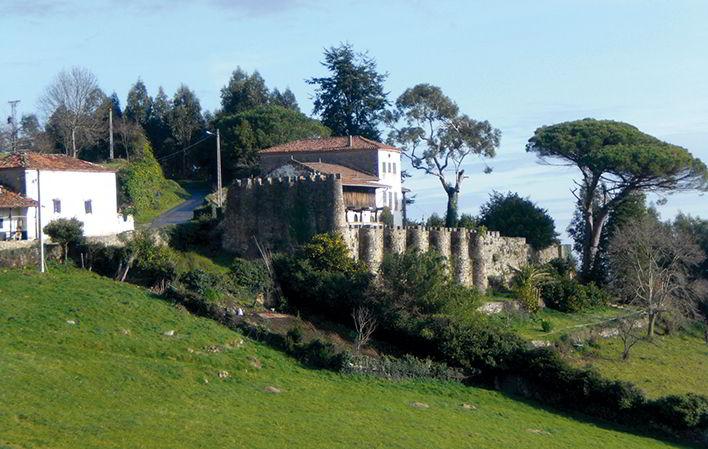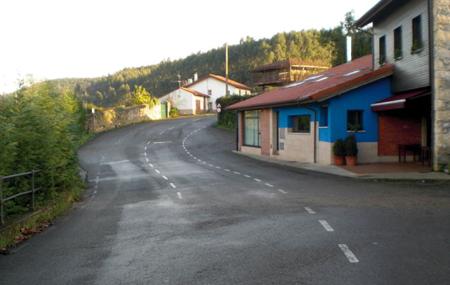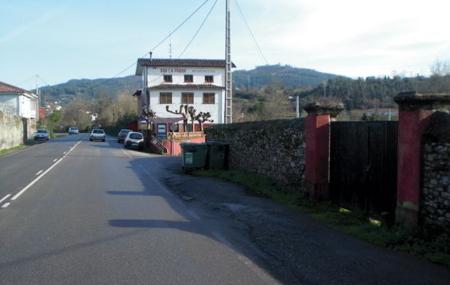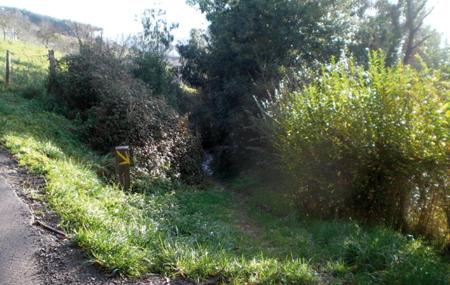
Stage 1: Gijón/Xixón - Amandi
- Address Gijón and Villaviciosa Asturias Centre
- Distance Distance: 24,2 kms
- Difficulty Difficulty: Short
- Code Code: GR108 Travesía Andariega (Walking Traverse)
- Altitude Altitude: 440 m.
- Unevenness Unevenness: 682 m.
- On foot On foot: 6 h. 20 min.
- Start point Start point: La Guía (Gijón/Xixón)
- Route type Route type: Hiking
- Tour type Tour type: Crossing
- Layout of the route Layout of the route: Download kml
Suitable for MTB.
Route
Gijón/Xixón - Amandi 24,2
The route starts in La Guía next to the Covadonga Group facilities, near where the Peñafrancia stream flows into the river Piles.
Take the path that passes under the motorway and take the turning to the left, which passes behind the School of Industrial Engineering. The path enters a leafy area on the banks of the stream, which leads us to the El Tragamón golf course, in view of the old mill. We continue along the path next to the golf course buildings, to later cross this road and continue along the Los Maizales path, leaving La Carbayera'l Tragamón on our left, an impressive forest of centenary oak trees, and next to it the La Isla estate, entrance to the Botanical Garden, where we can discover how the old Molín de Rionda used to work.
The path comes out onto the Santurio road, which we follow for a few metres before crossing it and arriving at the estate where the chapel of Nuestra Señora de la Corrada (16th century, possibly of medieval origin) is located, which was part of the ancestral home of the Cifuentes family. The path again follows the banks of the Peñafrancia, bordering the fields, where we find the emblazoned house of the García Jove family (17th century) with a chapel and breadbasket, before passing through the area known as La Charca, a great place to stop at the La Castañal fountain. We then cross the road to El Trole, in front of another prestigious llagar, to continue along the caleya'l Molín and enter the La Pontica neighbourhood, after crossing a small bridge, where we come across what was once the mill of Pepín de La Isla or Valiente (today a village house with granary), returning to the stream after passing the Occupational Training Centre and arriving at the entrance to the house, where the so-called molín de Segundo'l Molín used to be.
Leaving the road, we immediately enter the parish of Deva, in the La Reguera neighbourhood, leaving behind the turn-off that leads to the campsite and heading towards what was once the Deva mill, to then continue under the shade of tall trees that mark the entrance to La Quinta'l Conde, which displays the coats of arms of historic Gijón lineages. We then admire the parish church of San Salvador de Deva, a monastery founded in the 10th century, of which the walled arches of the north wall and some interior capitals in the Asturian pre-Romanesque style are still preserved.
The path ends in a paradisiacal space: El Güeyu Deva, with its fountain, washhouse and stone bridge, where the water flows into a large pond. From the "güeyu", or eye, from which the stream rises, legend has it that the "xanas" (Asturian water nymphs) used to come out, appearing on certain special dawns, such as that of San Xuan, when they could be disenchanted. Symbol of the cult of the Celtic goddess of nature Deva, worshipped in springs and rivers such as these, where the hermitage of Nuestra Señora de la Peña de Francia (17th century) seems to want to Christianise this sacred space.
Take the road that goes uphill and passes next to the El Chabolu bar. Shortly after, you pass over the motorway and start a steep climb up the Cuesta de la Barrea.
When you reach the road, turn right and shortly after you pass by the Pinal Restaurant, which has a church that looks Romanesque but is of recent construction. From here you have an excellent view of Gijón and the entire coastline. Continuing along the road we reach the Alto del Curbiello.
When we reach the top, the road starts to descend towards Pión, and we must take a turning to the left that leaves us a few metres from the top, taking us onto a path that heads eastwards.
We leave the road to take a narrow path to the right. We descend, squeezed through the vegetation, to pass shortly after Requexu, then next to D. Ramón Álvarez de Arriba's Practical School of Agriculture and connect, shortly after, with the road that we had left on the Alto del Curbiello. Once there, continue down towards Pión, ignoring the crossroads until you reach the Casa Pepito bar.
Continue along the road in front of us, ignoring the one on the left that says Villaviciosa. Shortly afterwards the road turns to the left, from where another road leads off to the right towards the Casamoria neighbourhood. Continue along this road in a southerly direction, ignoring any detours and ignoring the signs that the Tertulia del Garrapiellu has put up indicating the way, as if you follow them you will enter an area of eucalyptus trees that is completely flooded with mud, making it extremely difficult to walk. To avoid this we should continue along the road that goes in search of the one we have left next to Casa Pepito. When you reach it, turn right and climb up to the Alto de la Cruz, from where you have an excellent view of the Peón valley, with a glimpse of Gijón/Xixón and El Musel. From here the road begins a slight descent for about 500 metres. Leave the road to take the path on the right which starts a descent in the shade of the eucalyptus trees in search of the village of Niévares.
Leave the track to take the path on the right, which starts a steep descent through the vegetation, until you reach a granary with an iron gate on the right, where the path widens out towards the outskirts of Niévares.
In the locality of Niévares (Villaviciosa) we find: the Necrópolis Tumular de La Llaguna de Nievares, in the Alto de Pedroso (elevation 480), next to the Alto de La Cruz; and the Palacio de La Torre de Niévares, a castle-fortress complex (late Middle Ages), made up of a manor house, panera and chapel, surrounded by a wall.
When you reach the road, turn left and then right again a few metres further on. As we go down we see on the left the Tower of Niévares, a set of mansion, panera and chapel surrounded by a wall, and which dates from 1501 according to an inscription on the main façade of the palace. The wall is formed by irregular stone blocks with crenellated tops, and that according to Cortina Frade can go back to Roman times. The tower has a rectangular floor plan with a gabled roof and a square tower. We continue along the road, and after a few metres there is a turning to the left which we can follow as it leads to the road we will pass later on.
When you reach the road, turn left and continue along it, passing under the motorway to reach Grases. We continue along the VV-10 road, through a rural landscape that passes through the villages of Grases and Casquita, to reach La Parra next to the AS-255 road.
On reaching the road, we turn left and then turn right again a few metres later, next to the La Parra bar. We soon pass the Roman bridge that crosses the river, already in Amandi. Once over the bridge we reach a small square, where we find the chapel/hermitage of San Juan de Amandi, which we leave on the left to go in search of the road from Villaviciosa to L' Infiestu. Here it is worth turning left along the road for about half a kilometre to visit the Church of San Juan, declared a National Monument on 3rd June 1931, and whose origins date back to the 13th century, although there is evidence of its existence as early as 1270, as it is mentioned in the Town Charter of Maliayo (Villaviciosa).
On the road we turn right, walking along it towards the village of Valbúcar, where there is a bar where we can quench our thirst and continue on our way. This could be the end of the first stage if you want to do the route in three days.
Texts: Antonio Alba Moratillas (Editorial Prames)
Map
Itinerary
Gijón/Xixón - Amandi




